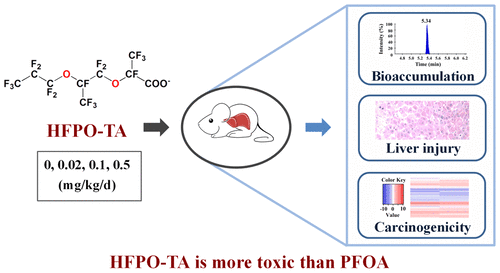当前位置:
X-MOL 学术
›
Environ. Sci. Technol.
›
论文详情
Our official English website, www.x-mol.net, welcomes your
feedback! (Note: you will need to create a separate account there.)
Hepatotoxic Effects of Hexafluoropropylene Oxide Trimer Acid (HFPO-TA), A Novel Perfluorooctanoic Acid (PFOA) Alternative, on Mice
Environmental Science & Technology ( IF 10.8 ) Pub Date : 2018-07-05 , DOI: 10.1021/acs.est.8b01714 Nan Sheng 1 , Yitao Pan 1 , Yong Guo 2 , Yan Sun 2 , Jiayin Dai 1
Environmental Science & Technology ( IF 10.8 ) Pub Date : 2018-07-05 , DOI: 10.1021/acs.est.8b01714 Nan Sheng 1 , Yitao Pan 1 , Yong Guo 2 , Yan Sun 2 , Jiayin Dai 1
Affiliation

|
As an alternative to perfluorooctanoic acid (PFOA), hexafluoropropylene oxide trimer acid (HFPO-TA) has been increasingly used for fluoropolymer manufacture in recent years. Its growing detection in environmental matrices and wildlife raises considerable concern about its potential health risks. Here we investigated the effects of HFPO-TA on mouse liver following 28 days of exposure to 0.02, 0.1, or 0.5 mg/kg/d of HFPO-TA via oral gavage. Results showed that HFPO-TA concentrations increased to 1.14, 4.48, and 30.8 μg/mL in serum and 12.0, 32.2, and 100 μg/g in liver, respectively. Liver injury, including hepatomegaly, necrosis, and increase in alanine aminotransferase activity, was observed. Furthermore, total cholesterol and triglycerides decreased in the liver in a dose-dependent manner. Liver transcriptome analysis revealed that 281, 1001, and 2491 genes were differentially expressed (fold change ≥2 and FDR < 0.05) in the three treated groups, respectively, compared with the control group. KEGG enrichment analysis highlighted the PPAR and chemical carcinogenesis pathways in all three treatment groups. Protein levels of genes involved in carcinogenesis, such as AFP, p21, Sirt1 C-MYC, and PCNA, were significantly increased. Compared with previously published toxicological data of PFOA, HFPO-TA showed higher bioaccumulation potential and more serious hepatotoxicity. Taken together, HFPO-TA does not appear to be a safer alternative to PFOA.
中文翻译:

新型全氟辛酸(PFOA)替代物六氟环氧丙烷三聚体酸(HFPO-TA)对小鼠的肝毒性作用
作为全氟辛酸(PFOA)的替代品,近年来,六氟环氧丙烷三聚酸(HFPO-TA)越来越多地用于制造含氟聚合物。它在环境基质和野生动植物中的日益增长的检测引起了对其潜在健康风险的极大关注。在这里,我们通过口服管饲法,在0.02、0.1或0.5 mg / kg / d HFPO-TA暴露28天后,研究了HFPO-TA对小鼠肝脏的影响。结果显示,血清中的HFPO-TA浓度分别增至1.14、4.48和30.8μg/ mL,肝脏中分别增至12.0、32.2和100μg/ g。观察到肝损伤,包括肝肿大,坏死和丙氨酸氨基转移酶活性增加。此外,肝脏中的总胆固醇和甘油三酸酯以剂量依赖性方式降低。肝转录组分析显示281,1001,与对照组相比,三个治疗组分别表达了2491和2491个基因的差异表达(倍数变化≥2,FDR <0.05)。KEGG富集分析突出了所有三个治疗组中的PPAR和化学致癌途径。参与致癌作用的基因(例如AFP,p21,Sirt1 C-MYC和PCNA)的蛋白质水平显着增加。与以前发表的PFOA的毒理学数据相比,HFPO-TA具有更高的生物蓄积潜力和更严重的肝毒性。综上所述,HFPO-TA似乎不是PFOA的更安全替代品。KEGG富集分析突出了所有三个治疗组中的PPAR和化学致癌途径。参与致癌作用的基因(例如AFP,p21,Sirt1 C-MYC和PCNA)的蛋白质水平显着增加。与以前发表的PFOA的毒理学数据相比,HFPO-TA具有更高的生物蓄积潜力和更严重的肝毒性。综上所述,HFPO-TA似乎不是PFOA的更安全替代品。KEGG富集分析突出了所有三个治疗组中的PPAR和化学致癌途径。参与致癌作用的基因(例如AFP,p21,Sirt1 C-MYC和PCNA)的蛋白质水平显着增加。与以前发表的PFOA的毒理学数据相比,HFPO-TA具有更高的生物蓄积潜力和更严重的肝毒性。综上所述,HFPO-TA似乎不是PFOA的更安全替代品。
更新日期:2018-07-08
中文翻译:

新型全氟辛酸(PFOA)替代物六氟环氧丙烷三聚体酸(HFPO-TA)对小鼠的肝毒性作用
作为全氟辛酸(PFOA)的替代品,近年来,六氟环氧丙烷三聚酸(HFPO-TA)越来越多地用于制造含氟聚合物。它在环境基质和野生动植物中的日益增长的检测引起了对其潜在健康风险的极大关注。在这里,我们通过口服管饲法,在0.02、0.1或0.5 mg / kg / d HFPO-TA暴露28天后,研究了HFPO-TA对小鼠肝脏的影响。结果显示,血清中的HFPO-TA浓度分别增至1.14、4.48和30.8μg/ mL,肝脏中分别增至12.0、32.2和100μg/ g。观察到肝损伤,包括肝肿大,坏死和丙氨酸氨基转移酶活性增加。此外,肝脏中的总胆固醇和甘油三酸酯以剂量依赖性方式降低。肝转录组分析显示281,1001,与对照组相比,三个治疗组分别表达了2491和2491个基因的差异表达(倍数变化≥2,FDR <0.05)。KEGG富集分析突出了所有三个治疗组中的PPAR和化学致癌途径。参与致癌作用的基因(例如AFP,p21,Sirt1 C-MYC和PCNA)的蛋白质水平显着增加。与以前发表的PFOA的毒理学数据相比,HFPO-TA具有更高的生物蓄积潜力和更严重的肝毒性。综上所述,HFPO-TA似乎不是PFOA的更安全替代品。KEGG富集分析突出了所有三个治疗组中的PPAR和化学致癌途径。参与致癌作用的基因(例如AFP,p21,Sirt1 C-MYC和PCNA)的蛋白质水平显着增加。与以前发表的PFOA的毒理学数据相比,HFPO-TA具有更高的生物蓄积潜力和更严重的肝毒性。综上所述,HFPO-TA似乎不是PFOA的更安全替代品。KEGG富集分析突出了所有三个治疗组中的PPAR和化学致癌途径。参与致癌作用的基因(例如AFP,p21,Sirt1 C-MYC和PCNA)的蛋白质水平显着增加。与以前发表的PFOA的毒理学数据相比,HFPO-TA具有更高的生物蓄积潜力和更严重的肝毒性。综上所述,HFPO-TA似乎不是PFOA的更安全替代品。











































 京公网安备 11010802027423号
京公网安备 11010802027423号